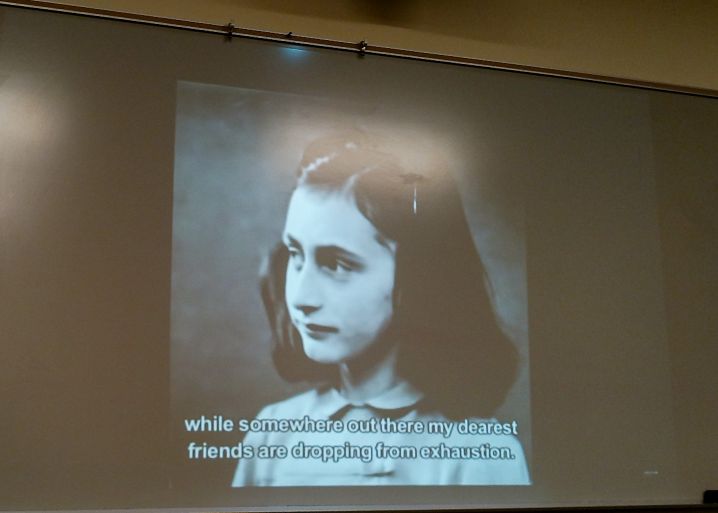by Audrey Anderson
Hometown Weekly Reporter
Westwood High School recently hosted a traveling exhibit in its library from October 18 to November 2. Titled "Anne Frank: A Global History," the show had already made a global tour, with stops including Tokyo, Serbia, China, and France, among other countries. Students at Westwood High were fortunate to view the detailed panels of the exhibit during an English class period as part of the regular school day. The exhibit was on view to the general public on the evening of October 30.
Guests entering the library were shown to a classroom where they viewed a short documentary about the exhibit and the history explored in it. Then, impressive, specially trained student volunteer docents from the tenth, eleventh and twelfth grades took visitors through the exhibit. The docents stopped at each panel to explain the significance of the photos and written details on it, and they answered questions from the visitors. Visitors reflected on the tragic story presented in the exhibit and studied the photographs on the panels.
The panels told the story of Anne Frank. She lived a normal life with her family in Germany until she was about four years old. At that point, the German army increased its restrictions and attacks on the Jewish population and on others not wanted in the Aryan society the Germans planned on building. No longer feeling safe in Germany, Frank's family moved to Amsterdam, where her father started a new company, and the family lived freely for a while.
In the course of the war, Germany conquered the Netherlands, and the same restrictions and attacks Jewish people suffered in Germany threatened Frank's family in their new home. When Frank was a young teenager, the family, along with a few others, went into hiding in an annex of her father's factory building. Employees of the company brought food to the family. Those in hiding could not make sounds, look out of the windows, cook, or do anything that would attract attention from the Germans.
Frank started to write about her experiences in a diary. In time, she heard that people's writings would be published after the war was over. She dreamed of being a writer, and started to write her entries on separate sheets of paper, so they would be ready for publication when the time came.
The Germans became aware of Frank's family's hiding place, arrested everyone, and brought them to the concentration camps. Sadly, every member of Frank's family, except her father, Otto Frank, died in the camps.
Miep Gies and Bep Voskuijl, secretaries in Otto Frank's company, found the diary and saved it. When Otto Frank returned at the end of the war, they gave the diary to him, and he had it published in his daughter's memory.
With the help of the student docents, visitors to the exhibit learned about the tragic details of the Frank family's story, and saw photos of the family, Frank's diary entries, the annex where the family hid, the concentration camps they were taken to, and the worldwide editions of her diary as published. The exhibit played its part in keeping the story of the Frank family, and others who suffered a similar fate in World War II, in our memories and in our determination that their story shall not be repeated.























